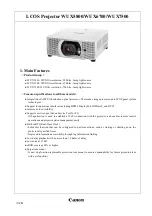
(13/28)
●
USB image input (for still images only)
When a USB memory containing image data is inserted to the USB terminal, the unit can project the
image data as an image.
Image data other than JPEG format cannot be used, and the maximum number of pixel for a picture is
10912x8640.
The unit supports only the most commonly-used format, and other formats are not supported, as shown
below:
Support
Format
Yes
Baseline DCT
No
Extended Sequential DCT
No
Progressive DCT
No
Lossless DPCM Spatial
** Digital zoom cannot be controlled on the screen for selecting the picture.
To set the slide show view of the USB image input, use the image setup menu.
To display the image of the USB image input, use the USB file browser.
●
NMPJ and network image input (for still images only)
Network multi projection (NMPJ) is a function that enables the projector to receive computer screen
information over a network and project it.
This function can be used by installing the NMPJ program in the computer.
・
Obtaining NMPJ
The program is provided for free.
The method to obtain the program varies depending on the country or region, but it is mainly
downloaded from the service webpage.
・
NMPJ operation
When NMPJ is executed on a computer, the screen information is sent as data consisting of
consecutive still images to the projector over a network using Canon’s original protocol.
The resolution of the still image data is converted to match the number of pixels of the projector’s
image device (LCOS) before the data is output.
・
Image quality setting of NMPJ
Select whether to prioritize image quality or frame rate.
High
Image quality is prioritized by reducing the frame rate.
The image is sent without compression (by maintaining the image quality).
Middle
A standard setting in which a balance between image quality and frame rate
is taken into account.
Low
Frame rate is prioritized by reducing the image quality.
Use this setting when you want to reduce the network bandwidth being used.
File type
JPEG
Format
Baseline DCT
Maximum pixels
10912x8640














































